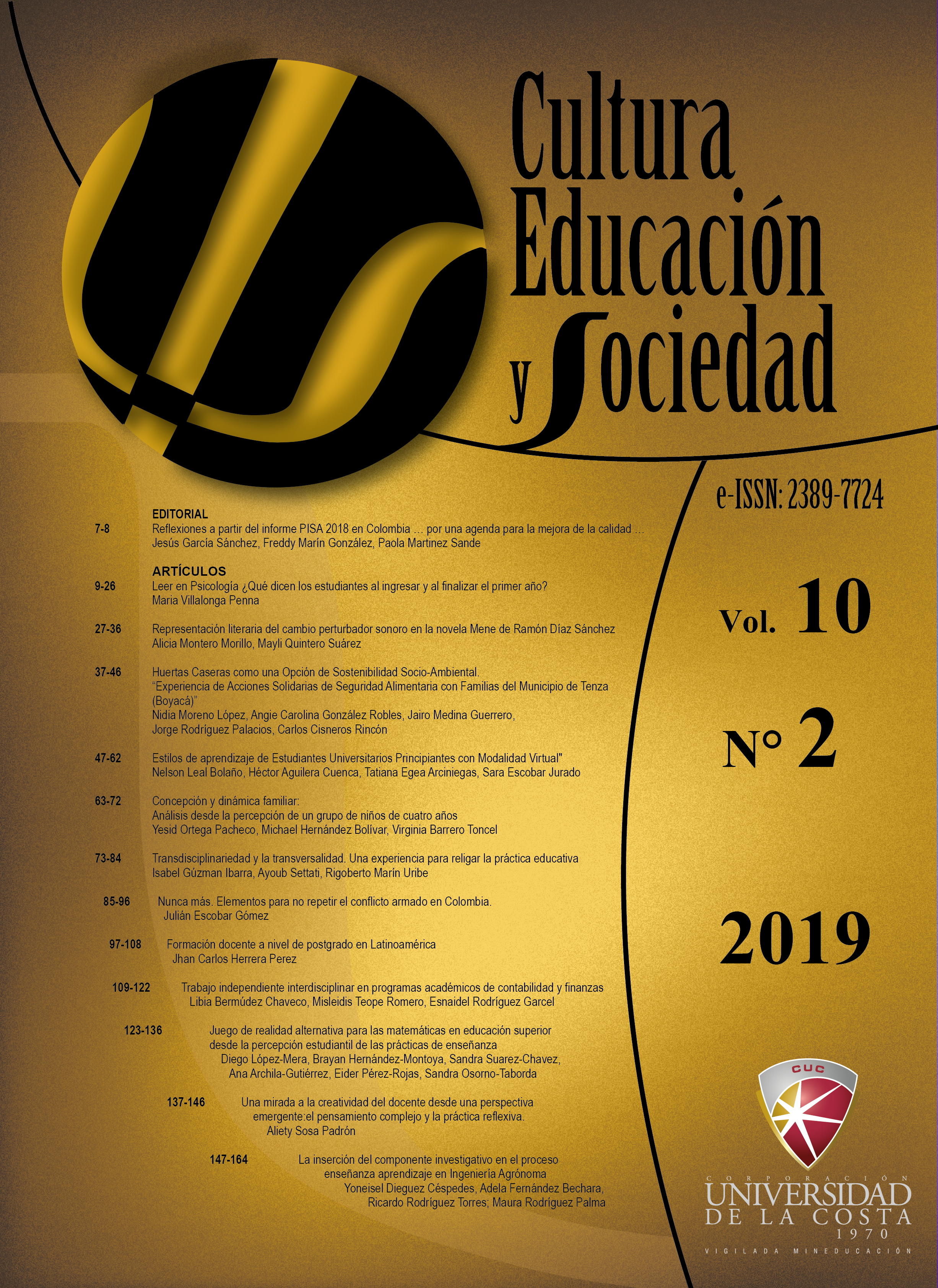A look at the creativity of the teacher from a reflective pedagogical practice
DOI:
https://doi.org/10.17981/cultedusoc.10.2.2019.11Keywords:
Creativity, Reflective pedagogical practice, Teacher trainingAbstract
It is a problem for education, the fact that creativity has been touched by the crisis through which it crosses; followed by a social, political and economic crisis; that has brought about that new theories approach and are ready to contribute to improve it. Therefore, as part of a new investigation, creativity is presented from complex thinking and reflective practice.Methodologically, 20 authors, trends and criteria were referenced in databases such as: CONRICYT, REDALYC and SCIELO. The theory and the sessions of work with the teachers, allowed the construction of a collegiate concept of creativity permeated by these theories, moving towards a pattern of observation to operationalize the concept with the elements that synthesize it and that is specified in three sectionsAs a result, not only the potential of the creative teachers towards which the guideline was directed, but also the gaps that still remain in practice could be seen. It allowed us to analyze together, how class planning is carried out, its intervention in the classroom and the evaluation of the class referring to the previously constructed conceptIt was concluded that there is evidence that creative teachers remain in the classrooms, which recognize the need to incorporate other criteria in their practice, so that creative education, ideally must be complex and reflective, to ensure that they are the teachers, who rewrite his creative acting mode, depending on a student that responds to the times he lives.
Downloads
References
Archila, G, J. (2013). Educación y pedagogía en el contexto del paradigma emergente: una nueva forma de pensar y percibir el mundo para la formación de ciudadanía. Revista Logos, Ciencia & Tecnología, 5(1), 139–147. Disponible en https://www.redalyc.org/pdf/5177/517751547011.pdf
Amabile, T. (1983). The social psychology of creativity: A componential conceptualization. Journal of personality and social psychology, 45(2), 357–376. https://doi.org/10.1037/0022-3514.37.2.221
Betancourt, M. (1997). Condiciones necesarias para propiciar atmósferas creativas. Revista Universal Universitaria, 10(12), 1-9. Recuperado de http://www.revista.unam.mx/vol.10/num12/art85/art85.pdf
Cárdenas, N. y Angulo, F. (2016). Análisis de las dimensiones de adaptación, mejoramiento e innovación en los procesos de aprendizaje tecnológico. Cultura Educación y Sociedad, 7(2), 139–149. Recuperado a partir de https://revistascientificas.cuc.edu.co/culturaeducacionysociedad/article/view/1468
Caballero, E. (2012). La creatividad pedagógica en la formación del docente. Revista Didáctica y Educación, 3 (4), 1 15–127. Disponible en https://dialnet.unirioja.es/servlet/articulo?codigo=4231952
Castillejo, P., Pèrez-Alonso, M., Rodrìguez, T., Sarramon, J., Touriñan, J., Vazquez, G. (2012). Creatividad, educación e innovación: emprender la tarea de ser autor y no solo autor de sus propios proyectos . Revista de investigación en educación, 7–29.
Chibás-Ortiz, F. (2012). Creatividad + Dinámica de Grupo = Eureka. La Habana: Pueblo y Educación.
Cisterna, F. (2005). Categorización y Triangulación como Procesos de Validación del Conocimiento en Investigaciones Cualitativas. Theoria, 14(1) 61– 71. Disponible en https://www.redalyc.org/pdf/299/29900107.pdf
Csikszentmihalyi, M. (1998). Creatividad: el fluir y la psicología del descubrimiento y la invención. Barcelona: Paidós. Recuperado de https://campus.fundec.org.ar/admin/archivos/Mihaly_2.pdf
De Bono, E. (1986). El pensamiento lateral. Barcelona. Ediciones Paidós.
Dewey, J. (1933). How We Think: A Restatement of the Relation of Reflective Thinking to the Educative Process. Boston: D.C. Heath & Co Publishers.
Guilford, J. y Strom, R. (1978). Creatividad y Educación. Buenos Aires. Paidós.
López, L. (2015). Conocimiento, pensamiento complejo y universidad. Revista Cubana de Educación Superior. 34(2). 28–33. Recuperado de http://scielo.sld.cu/scielo.php?script=sci_arttext&pid=S0257-43142015000200003
Marín, F., Cabas, J., Cabas, L. y Paredes, A. (2018). Formación Integral en Profesionales de la Ingeniería. Análisis en el Plano de la Calidad Educativa. Formación Universitaria, 11(1), 13–24. http://dx.doi.org/10.4067/S0718-50062018000100013.
Martínez, M. (2009). Maestro y creatividad ante el siglo XX I. En, M. Martínez Llantada y Guanche, A. (Compil.). En, El desarrollo de la creatividad. Teoría y práctica en la educación (pp.109–116). La Habana: Pueblo y Educación.
Maldonado, C. (2014). ¿ Qué es eso de pedagogía y educación en complejidad. Intersticios sociales, 7(1), 1–23. Disponible en https://www.redalyc.org/pdf/4217/421739500002.pdf
Monsalve, M. (2015). Paradigma de la complejidad en educación. Atlante: Cuadernos de Educación y Desarrollo. Disponible en: http://www.eumed.net/rev/atlante/2015/12/escuela.html
Morin, E. (2003). Introducción al pensamiento complejo. Barcelona: Gedisa
Mujica, M., Marín, F. Smith, H. y Lovera, M. (2008). Municipio innovador, un modelo para el desarrollo local sostenible. Multiciencias, 8(Extraordinario), 130–136. Disponible en https://www.redalyc.org/pdf/904/90411691019.pdf
Remedios, J. M. (2016). Pedagogía para el desarrollo de la creatividad en educación y para la educación. Lima: Magisterial.
Schön, D. (2010). La formación de profesionales reflexivos: hacia un nuevo diseño de la enseñanza y el aprendizaje en las profesiones. Madrid: Paidós.
Sternberg, R. y Lubart, T. (1997). La creatividad en una cultura conformista. Un desafío las masas. Madrid: Paidós.
Torrance, E. (1965). Opiniones científicas de la creatividad y factores que afectan su crecimiento. Dédalo, 94(3), 663–681.
Published
How to Cite
Issue
Section
License
Copyright (c) 2019 CULTURA EDUCACIÓN Y SOCIEDAD

This work is licensed under a Creative Commons Attribution-NonCommercial-NoDerivatives 4.0 International License.
![]()
Creative Commons 2020 CULTURA EDUCACIÓN Y SOCIEDAD
This article is under international license Creative Commons Reconocimiento-NoComercial-SinObrasDerivadas 4.0.
The published articles are the sole responsibility of their authors and do not necessarily reflect the opinions of the editorial committee.
CULTURA EDUCACIÓN Y SOCIEDAD respects the moral rights of its authors, who assign to the editorial committee the patrimonial rights of the published material. In turn, the authors inform that this work is unpublished and has not been previously published.
All articles are under a:
Licencia Creative Commons Atribución-NoComercial-SinDerivadas 4.0 Internacional.
![]()


 English
English
 Español (España)
Español (España)




_12.53_.27_p_. m_._3.png)





_12.57_.35_p_. m_._3.png)
_12.50_.37_p_. m_._3.png)



